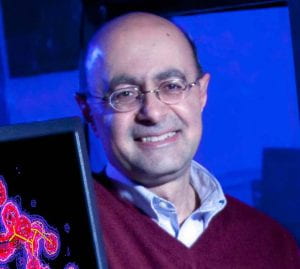ourmazd[at]uwm.edu
 Biography
Biography
Abbas Ourmazd is currently Distinguished Professor of Physics and Electrical Engineering at the University of Wisconsin-Milwaukee. He has held leadership positions on both sides of the Atlantic. These have included academia (Oxford, Göttingen, Brandenburg, Wisconsin), industry (Bell Labs), national laboratories (IHP), entrepreneurial start-ups (Lesswire, Communicant), and professional societies (American Physical Society). His advisory activities have included industry (AT&T, Lucent Microelectronics), national labs (Lawrence Berkeley Lab, Naval Research Lab, National Renewable Energy Lab), government agencies (US Dept of Energy, German Federal Ministry of Education & Research, State Minister of Economic Affairs and Technology), professional societies (the APS Committee on International Scientific Affairs, the Physics Planning Committee, US Congressional Science Fellows), and national funding agencies in the US and Europe (DoE, NSF, the Semiconductor Research Corporation in the US; the German Ministry of Education & Research, and the Volkswagen Foundation in Germany).
In additional to research and administrative leadership, Dr. Ourmazd has raised multi-hundred million dollar institutional and entrepreneurial funds, overseen the design and construction of major new facilities, and launched and managed two companies. He has also led the development and commercialization of high-value intellectual property portfolios, including licensing and cross-licensing arrangements with ASM, Bristol-Myers Squibb, Intel, MIPS, and Motorola.
Dr. Ourmazd’s research interests include electron holography, technologies for broadband mobile communication systems and hotspots, and, most recently, determining the structure of individual biological molecules. He has a strong track record of stimulating and nurturing multidisciplinary work.
Dr. Ourmazd’s publications include more than 150 papers in refereed journals, 10 patents, and over 350 invited presentations at national and international meetings and colloquia. He enjoys teaching over a wide range, from fundamental science and technology to business innovation, and has extensive experience in working with graduate students and postdoctoral fellows.
Dr. Ourmazd’s awards include an Alexander-von-Humboldt Fellowship, and the Johnson-Matthey prize. He is a Fellow of the American Physical Society
Dr. Ourmazd is a US citizen, bilingual (English and German), and a graduate of Oxford University.
Objectives
Develop and apply advanced algorithms with broad impact on physics, chemistry, biology, astronomy, and machine learning. Educate the next generation of leaders in computational science.
Professional Appointments
|
|
2005 – present |
| Developed and applied machine-learning algorithms to determine the structure of biological molecules, compile molecular movies and energy landscapes of nanomachines from random sightings, and extract femtosecond spectral movies of breaking of chemical bonds from data with 300fs timing uncertainty. Helped secure and co-steer a $25M NSF Science & Technology Center. Trained undergraduates, graduate students, and postdoctoral coworkers in computational science. Published results in Nature, Science, PNAS, and Royal Society journals. | |
|
|
2005 – 2007 |
| Secured increased funding from State, launched research growth initiative, collaborated with industry, established UWM Research Foundation. | |
|
|
1995 – 2005 |
| Developed algorithms for secure hot-spot communications, led research in communication technologies. | |
|
|
1995 – 2005 |
| Research Institute with 200 members of technical staff with focus on communications technologies. Licensed and transferred technologies to Intel, Motorola, ASM. Initiated startups, acting as Chairman of two. | |
|
|
1994 – 1995 |
| Responsible for R&D strategy, including research and transfer of algorithms. | |
|
|
1987 – 1994 |
| Responsible for R&D and technology transfer in materials, devices, and systems. | |
|
|
1984 – 1987 |
| Performed fundamental research in condensed matter. Developed algorithms for extracting quantitative information from electron micrographs. | |
|
|
1983 – 1984 |
| Performed research on dislocations and point defects in solids. | |
|
|
1980 – 1983 |
| Developed models for the electrical activity of extended defects. | |
Synergistic Appointments
|
|
2017 – present |
|
|
2013 – present |
|
|
2006 – 2010 |
|
|
2005 – 2007 |
|
|
1996 – 2002 |
|
|
1994 – 1996 |
|
|
1994 – 1996 |
|
|
1992 – 1995 |
|
|
1994 – 1995 |
|
|
1993 – 1995 |
|
|
1990 – 2002 |
|
|
1994 |
|
|
1993 |
|
|
1993 |
|
|
1992 |
|
|
1990 |
Academic Output & Distinctions
Education
|
|
1976-1980 |
|
|
1973-1976 |
Patents
| No. | Patent Title | Application /Award Number | Filing / Award Date |
| 1 | Device Using Ordered Semiconductor Alloy | 4,661,829 | 28.04.1987 |
| 2 | Method of Controlling the Order-Disorder State in a Semiconductor Device | 4,879,256 | 07.11.1989 |
| 3 | Insulated Gate Field-Effect Transistor with Pulse-Shaped Doping | 5,166,765 | 24.11.1992 |
| 4 | Method and System for Remotely Controlling an Interactive Voice Response System | 5,850,429 | 12.15.1998 |
| 5 | System and method for identifying the location of a wireless terminal | 96309118.6-2209 | 13.12.1996 |
| 6 | Automated Message System | 5,799,066 | 08.25.1998 |
| 7 | MOS Transistor, and Production of Layers for that Type of Transistor | WO/1998/026456 DE 196 52 417 A1 |
08.12.1997 |
| 8 | Verfahren zur Herstellung von elektronischen Strukturen | DE 198 51 703.3 | 30.10.1998 |
| 9 | Bipolar Transistor | WO/2003/046947 DE 101 60511 A1 |
02.12.2002 |
| 10 | Automated Messages System For A Calling Party | US 6,381,311 B2 | 30.04.2002 |